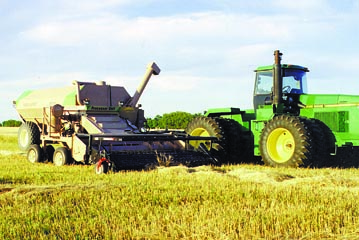FARM SHOW first reported two years ago on a revolutionary new harvest system that eliminates the need for a conventional combine (Vol. 20, No. 6). Since that time, inventor Bob McLeod has made great strides in developing the first-of-its-kind system. It features a tractor-mounted harvester that brings "dirty" grain to a stationary grain-cleaning mill back at the farm. "It's the first serious alternative in 100 years to the combine. Interest in this concept is growing by leaps and bounds," says McLeod, who has been conducting rigorous field tests over the past couple years to refine the system. McLeod has already received five patents on the system and has several others in the process. He has a mailing list of hundreds of farmers all over the world who have expressed interest in his idea and two combine manufacturers have proposed joint ventures. McLeod's idea is to use two machines instead of a single combine. The "harvester" mounts on an existing tractor. It uses a rotary system to separate grain, chaff, and weed seeds from the straw, which is left in the field. The partially threshed grain falls through the concaves and is then augered through an airlock to a pneumatic tube that blows it into a grain tank. The harvester can be fitted with either a direct cut or pickup-type header. It features a large 1,200 bu. grain box compared to the 250 to 300 bu. hoppers on most existing combines. The second machine is an on-farm mill that can be located back at the grain storage area. It mounts on a 7 by 24-ft. trailer. Powered by a 30 hp. electric motor it handles 800 bu. per hour, separating grain from the crop material gathered in the field. It cleans the crop to export standards using new air cleaning technology. It uses a roller mill to crush and compress the collected chaff and weed seeds as "savings" for use as livestock feed, litter, or for disposal. "The economics of the system are really startling," says McLeod. He figures an average-size farm operation will save thousands of dollars a year in operating costs, not counting the lower initial investment. "For example, there's virtually no grain loss out the back of the harvester in the field so we harvest more grain and eliminate volunteer crops the following season. Also, the value of taking weeds seeds off averages about per acre savings in herbicide and tillage expenses. The chaff, weed seeds, and other crop residue that accumulate as the grain is cleaned has a nutrient value per ton. In addition, we're delivering grain cleaned to export standards so there's no dockage." Developing the new harvest system has been a big job, says McLeod. He has taken on a couple of investors but doesn't want to sell out to a major manufacturer for fear the system would never get on the market. At this time, he's hoping to make his first sales of machines in the year 2000. "We estimate the cost of the complete harvesting system will be 25 percent less than a conventional combine," says McLeod.
1-800-834-9665
"Work Going Great" On Revolutionary Harvest Idea
FARM SHOW Magazine » "Work Going Great" On Revolutionary Harvest Idea
"Work Going Great" On Revolutionary Harvest Idea
